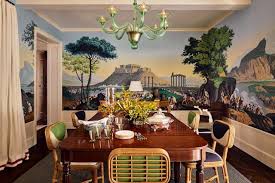How David Netto blended drama and sophistication in a Fifth Avenue apartment.
Let me share a secret with you: Sometimes I struggle with getting into character when designing a space. Every project requires a strong direction—a concept that resonates with the people who live there, those who look at the photos, or the designer creating it. At the start of this particular project, I found myself stuck—“nice apartment on Lower Fifth Avenue” didn’t exactly scream inspiration. But I wasn’t panicking just yet.

The clients were incredibly trusting. They’d listened to all my suggestions. They hired the talented architect David Hottenroth from Hottenroth + Joseph and allowed me to convince them to make some unconventional choices, like opening up room connections to create a looser, more loft-like feel. We were combining two apartments, and I pushed for fewer, larger rooms. They believed in me—truly the highest compliment a decorator can receive. Now it was my time to deliver something exceptional.
The moment of clarity came during a meeting, when I glanced down at the client’s sophisticated Italian surname on the floor plans. And just like that, the concept came into focus: Why not design an Italian-inspired New York apartment—not for the Agnellis, but something for us? A creative, eclectic twist on New York interiors, influenced by the owner’s name and fueled by my love for interiors defined by bold combinations of the old and new. Think traditional architecture paired with modern art, timeless 18th-century antiques beside bold contemporary furniture. And, perhaps most Italian of all, a vibrant color palette that my fearless client had requested.
“Why not create an Italian-inspired New York apartment—not for the Agnellis, but drawing inspiration from them?” —David Netto
And just like that, we were off. The process of shopping, presenting, and seeing the vision come together was one of the most rewarding experiences of my career. Let’s take a look at some of the standout pieces—and, equally important, the exciting pairings that make the apartment truly unique.
In the gallery, we’ve paired exceptional Louis XV blue-and-white ormolu-mounted cachepots from Emilio Terry with Henri Samuel’s cabinet, and Carlo Scarpa-designed chairs. In the living room, a Noa mosaic coffee table by Elisabeth Garouste complements a stunning George III armchair I found at Gerald Bland.
The library anchors with an iron and leather desk inspired by Jean-Michel Frank, accompanied by an antique Louis XVI fauteuil de bureau. Custom rift oak paneling adds depth and warmth to the room, and an antique rug from Katie Leede grounds the space, while a custom sectional sofa by Schneller in a warm cinnamon-hued Claremont linen velvet brings it all together.
Like the Agnelli homes we were nodding to, we used bold Bonacina pieces—but the contemporary, fearless kind. The finishes really set the tone too. The faux Iznik tiles used in the kitchen’s backsplash, inspired by a museum pattern, bring a touch of history. And that groovy zigzag Parish Hadley floor in the music room? It’s a playful contrast to the sophisticated furniture. Speaking of the music room, the room that made the biggest impact (and set the overall mood for the apartment) is the dining room, where Zuber’s Combats des Grecs wallpaper creates a striking, immersive atmosphere—made all the more surprising by the contemporary rattan chairs by India Mahdavi.
In the primary bedroom, a Ralph Lauren bed sits elegantly alongside a Louis XVI–style bench from Hubert de Givenchy’s collection. A Louis XVI armchair, upholstered in a Miles Redd check fabric from Schumacher, completes the space. Art by Joan Miró adds the final touch.
One of the most subtle touches of Italian influence lies in the height of the door hardware—slightly higher than typical American style (in Venetian palaces, you often see butlers reach up for the knobs). This detail, which I first saw used by Renzo Mongiardino in a legendary New York apartment, adds a sensual effect to the space—shifting how you experience the transition from one room to the next. It’s not just a visual cue—it’s a feeling.
But just because I got the “yes” on paper doesn’t mean I was off the hook. One of the most important skills in design is the ability to defend your choices. Take, for example, the architectural mirror I introduced to double the light and bring in a bit of glamour. While mirrored walls might sound appealing on paper, they can be tricky to pull off. I had to convince the clients that instead of looking overly decadent, the mirrors would make the walls nearly invisible, adding depth without distraction. These “hold the course” conversations are vital. If it doesn’t end with “I trust you,” the job’s not done.
So, what’s the takeaway from this experience? To compliment the lady of the house, who loves to entertain, I’ll sum up the project as a recipe:
Mix equal parts art, boldness, and quality.
Fold in two cups of 21st-century energy with one of the 18th century. Let it settle.
Add a strong point of view.
And most importantly: Invite everyone over, let the dog run through the living room, and enjoy the space.
This recipe is a reminder that great design doesn’t just create beautiful spaces—it creates a feeling. And that feeling? It’s what makes a home truly unforgettable.

